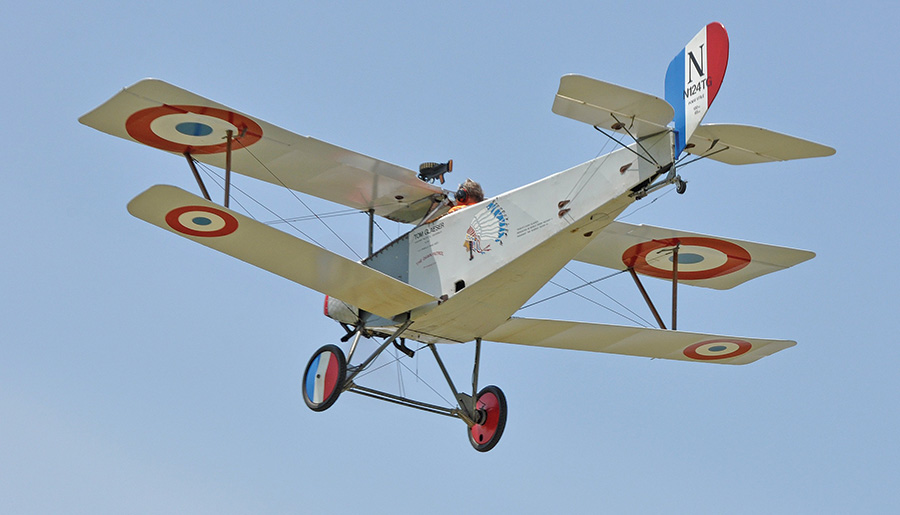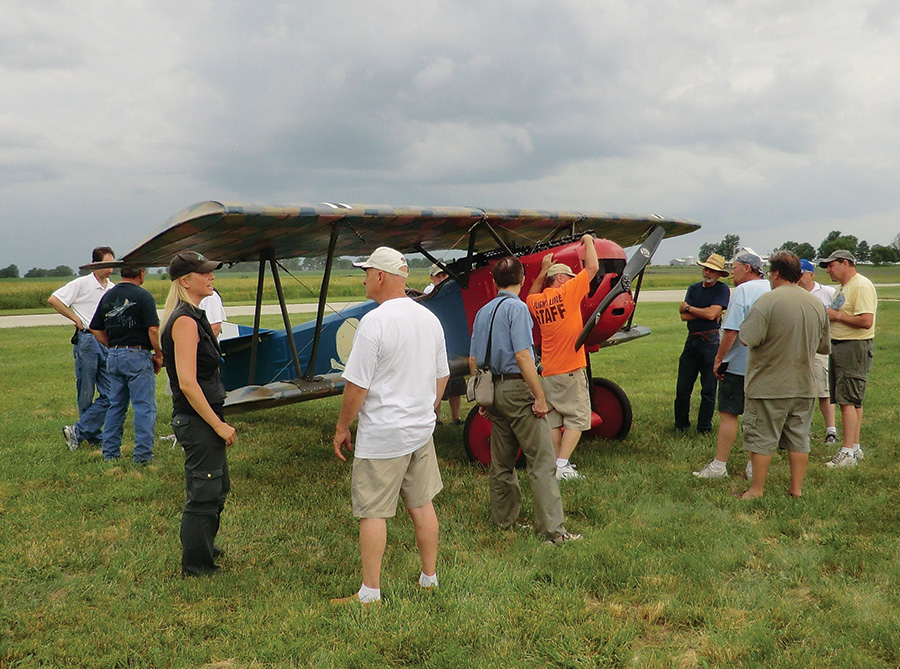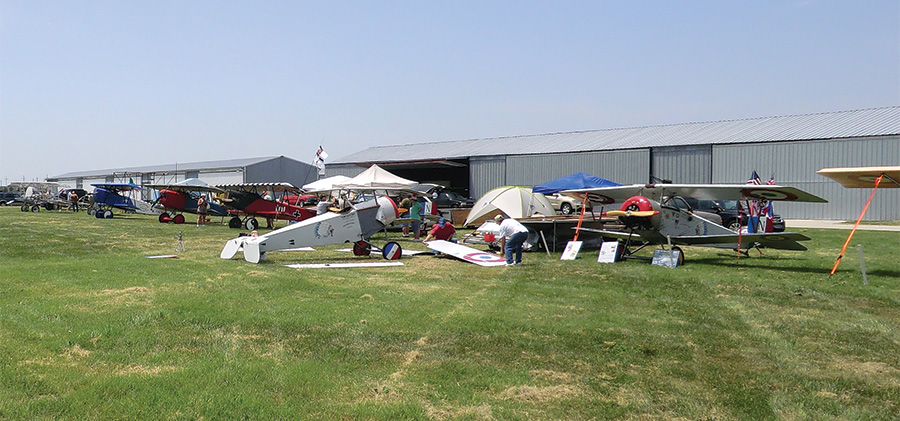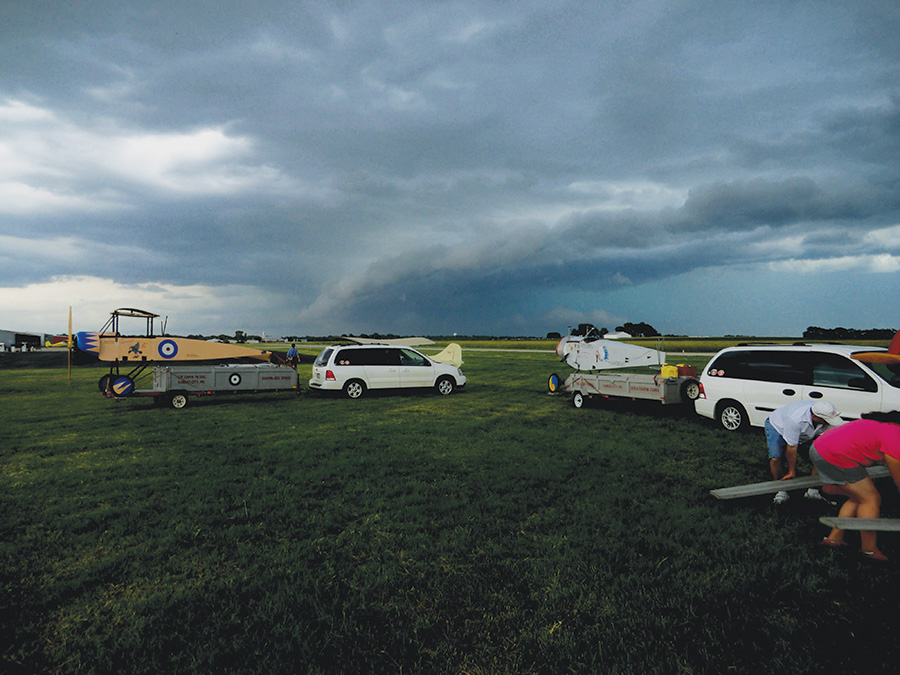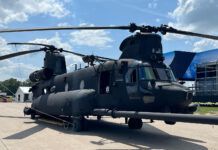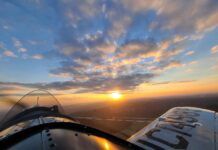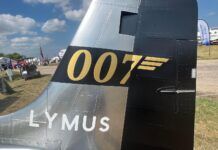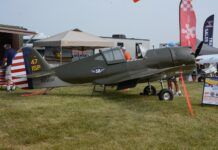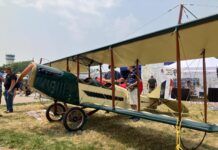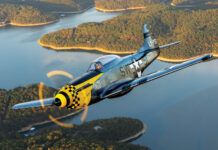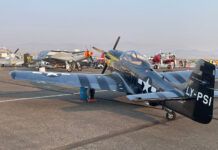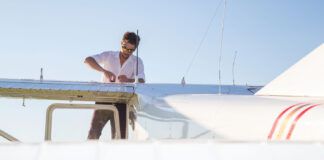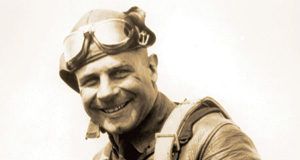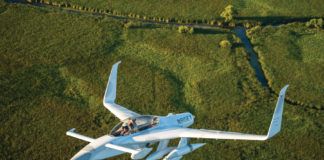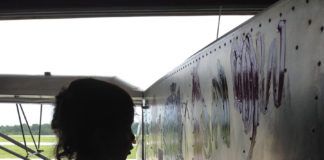“Don’t you dare bleed on those new socks,” Sweetie menacingly warned. It seemed I was not going to get any sympathy from her on this one. I was still doing my one-legged Riverdance imitation, hopping around on my left leg while hissing and whimpering in pain. This promised to be a record-setting “trailer ball knob!” That’s what we in the Dawn Patrol call that incandescent volcano of pain you get when you walk into the trailer hitch ball lurking at shin-bone level behind the car.
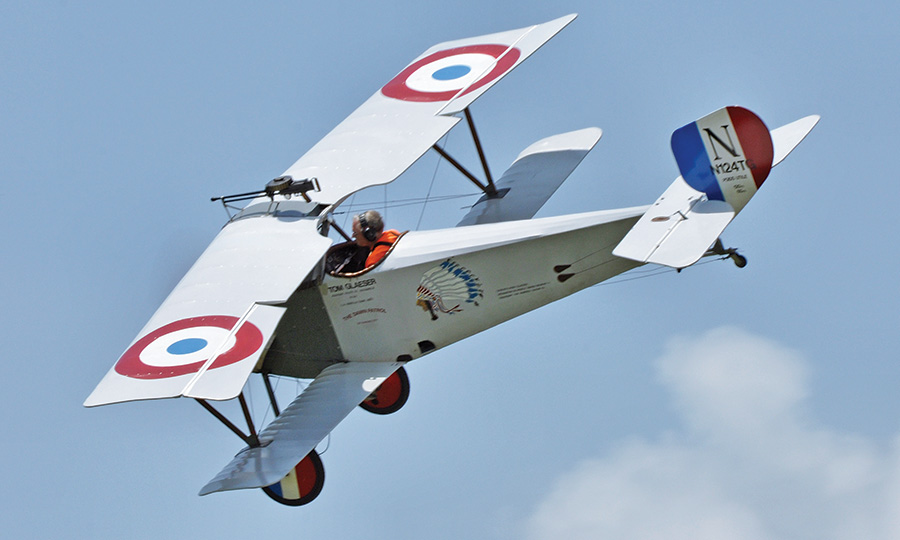
Tom Glaeser really put on a show in his Nieuport 11 for professional photographer Bob “Punchbob” Punch. Tom really redeemed himself from his “nine-point” landing at the Salute To Veteran’s Air Show held at the Memorial Day weekend in Columbia, Missouri. He made greaser landing after greaser landing for Bob Punch. Power is a direct-drive 1700cc VW with Sterba prop. Tom’s Nieuport is painted in the colors of the 1916 Lafayette Escadrille. (Photos by Bob Punch.)
We were at the 2013 Gathering of Eagles WW-I Fly-In at the Gardner, Kansas Municipal Airport. The Gathering of Eagles is an annual event. All individuals interested in building and flying WW-I aircraft eagerly await it. The weather this time was going to be really interesting. Missouri and Kansas weather in June is always a throw of the dice. In other words, if you don’t like the weather, just wait 15 minutes. As it turned out, the 2013 Gathering was going to be no different. The usual weather for this time is mind-numbing heat, wet wool blanket humidity and howling winds—not to mention afternoon convective buildups that can suddenly appear like magic. Yep Dorothy, we are definitely at a fly-in in Kansas.
Off to a Good Start?
Knowing the weather was going to be the usual, Sweetie and I arrived at Gardner Municipal Airport Friday morning at 7 a.m., towing her Airdrome Aeroplanes Morane-Saulnier Parasol replica and my Graham Lee Nieuport 11 replica. Our plan was to assemble them while it was relatively cool, before the wind started to really blow.
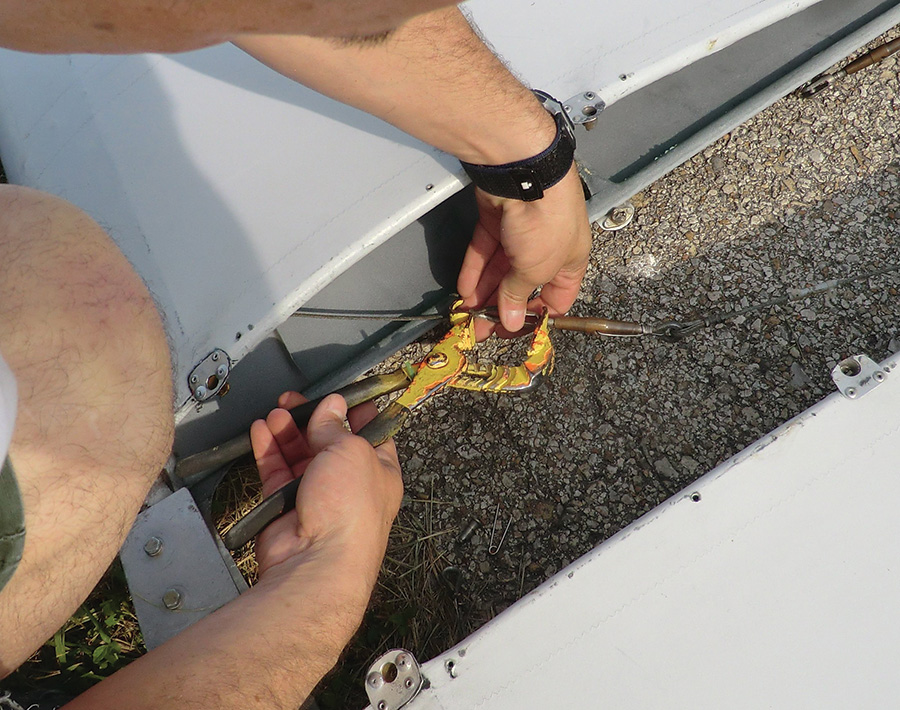
Dick Starks’ handy-dandy cable undoer thingy. It’s a highly modified pair of water pump pliers with special “ears” welded to each jaw of the pliers. The notch in the ears will capture the Nico press on the cable and the shoulders on the shackle on the end of the turnbuckle. This makes it super easy to take a cable off a turnbuckle without having to undo the turnbuckle.
Actually, it was pretty dang pleasant…the temperature was 74º and the winds were light from the southeast. It was just us. The field was deserted…but not for long.
We started on her Morane first. Robert Baslee (a.k.a. Bullwhip Baslee) had designed the Morane to be very trailer friendly. It was built to assemble fast, with just clevis pins with keepers needed to put 99% of the neat little bird together. The only tools needed were two 3/8-inch wrenches to connect the elevator control horns to the Teleflex cables that went from the stick to the elevators.
With the fuselage rolled off the trailer, the box containing the wings, tail feathers, and struts was opened. We started to unload the trailer. As I walked by the trailer, my right leg got tangled up with the trailer’s right wheel fender, and it peeled off about three square inches of skin as neatly as if I’d done it with a potato peeler. If you’ve ever messed with trailer-ing anything, this was nothing like the excruciating pain you get when you walk into a trailer ball. Now that is a real experience in pain management. This skin removal process didn’t hurt near as much, but the results were a lot more spectacular. Blood came out in a rushing tide of red, heading down to the aforementioned new socks (which, at this particular time, I really didn’t give a hoot about).
But, Sweetie wouldn’t hear of it. I was made to sit down while she mopped up the blood before those gold-plated, diamond-studded socks got stained. She applied about seven Band-Aids all over the oozing wound. It immediately started to swell up like a goose had laid an egg under the skin, but the blood was contained. We got back to putting planes together.
The Morane went together easily in about 25 minutes. (With “help” it usually runs 30 minutes to an hour.)
We had just finished the Morane when we heard an engine in the sky. We could see it was a biplane. As it got closer, we could see it was one of Robert Baslee’s Airdrome Aeroplanes Fokker D-7 replicas. Then we could see the color scheme and we knew who it was. It was “The Iron Man from Tulsa,” Mark Hymer, in his Fokker D-7. Mark was arriving after a two-and-a-half-hour, 157-nautical-mile, non-stop flight from Oklahoma. What a guy! Mark landed and taxied his beautiful bird up to where Sweetie and I were assembling our planes. Mark’s Butcher Bird is painted in the colors of the Fokker D-7 flown by the German Ace, Ernst Udet. Udet had a short little sentence painted on the top of his elevators, “Doch Du Nicht,” which can be loosely interpreted into, “No You Don’t.” Mark taxied up, shut down, and climbed out of his cockpit. Then, he jumped into helping us get the upper wing mounted on the Nieuport. Mark was the only “fly-in” at the gathering. The rest were “Trailer Weenies.”
On the Nieuport we do need help when mounting the top wing. Trailers loaded with planes were starting to arrive on the field. Aircraft assembly started with a vengeance. Now there was a lot of help available. The wind was coming up too, as expected. It took four helpers to steady the top wing on the Nieuport while the interplane struts, flying and landing wires, and lower wings were attached.
School Time
By noon the field had 12 WW-I aircraft securely staked down. The gusty southeasterly wind was a crosswind to any of the three runways at the field. So, everyone made sure their planes were securely tied down before the main activity for Friday started taking place. Pop-up canopies were set up, lawn chairs unfolded, and coolers opened. Now it was time for the real fun to start. This was the reason so many potential WW-I aircraft builders come to Gardner on the Friday before the big day on Saturday. They’re there to go to school!
Going to school meant going from plane to plane, project to project, and seeing what tricks of the trade or neat, improvised tools had been developed to make building or trailering easier. The shutter sounds of digital cameras made it sound like a company of crickets were on the field. There were also a lot of video recordings being made. It was a busy time—for everyone but me.
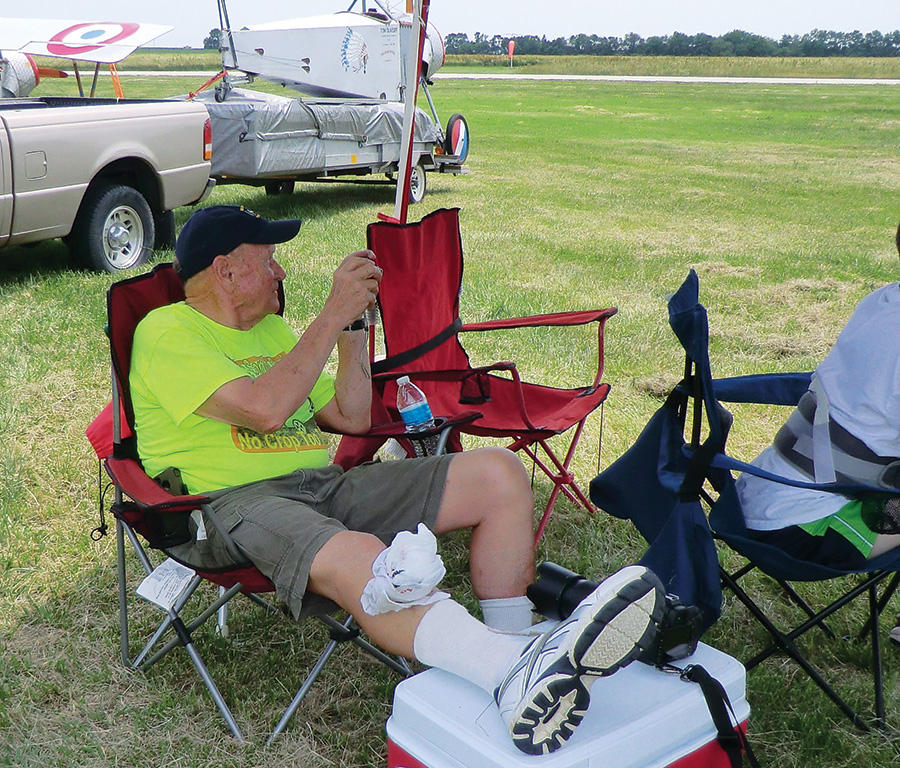
After Nurse Ratchet corralled me, I was confined to the canopy and my chair with an ice pack on my leg to try and keep the swelling down. It worked, too.
“Nurse Ratchet” had tracked me down, grabbed me by the ear, and made me sit down in a lawn chair under a canopy with an ice pack on my now-throbbing wound. It had swelled up to an admirable mound of shiny skin. I had a lot of sympathetic admirers. The only non-sympathetic person was the guardian of the still-pristine, non-bloody, family-heirloom sock. She had me on a schedule of 30 minutes on the ice pack and 30 minutes off.
During the off times, if I could escape her gimlet eye, I wandered up and down the flight line “going to school” myself. There are always so many neat ideas that show up at Gardner. You’ll look at something that a builder had done and say to yourself, “Dang…now why didn’t I think of that? It’s going to save 30 minutes of assembly time.” My little tool for taking cables and turnbuckles apart got a lot of attention. “Bullwhip” Baslee was always surrounded by questioners about his kits.
Let The Games Begin!
Saturday dawned with typical Kansas weather: hot, muggy, and winds forecast to be cross and gusty. There was also a good 50% chance of afternoon big, black surlys. (That’s our name for those convective Kansas storms that can appear out of nowhere and really ruin a good flying day.) But we’ve all been-there, done-that, suffered-through-it many times at Gardner. At some Gardner gatherings in the past, the weather has been so bad that no one flew. Besides, unlike other fly-ins and airshows, most of the people there had driven and flown all those miles to go to school—to get ideas, sniff at different designs, and talk to other builders and pilots about what plane was meant for them. This year we had visitors from as far away as New Mexico, Florida, and Idaho. The WW-I movement is definitely alive and well.
A bunch of us with flying aircraft really did want to fly and show the rest of the crowd how well these birds perform. So, we were kinda down about the gusty southeasterly crosswinds. We were pouting as we sat under the canopies. Our lower lips were stuck out so far a bird could have perched on them. We’d come to fly!
Then, wonder of wonders, the winds started to slowly back around to the south. Pretty soon they were almost straight down the big 3200- by 90-foot grass runway. The wind was still strong and gusty, but it was straight down the big grass runway! Sharon and I started to vibrate in place. We were giving each other the “I’ll-fly-if-you-will” look.
Suddenly, a raucous yell came from down at the other end of the flight line: “Send up the bump dummy!”
Sharon jerked upright in her folding chair and gave me an accusing look. “This is all your fault, ” she exclaimed. “You and your stupid Bump Dummy article…Somebody down there reads KITPLANES®!”
“Don’t you try to blame this on me,” I replied. “You know you want to fly. Come on…I’ll go with you.” (She was just putting on an act. She was glad that someone had pushed us off top-dead-center.) We performed a very careful pre-flight of our birds, got in, started up, and waddled out to the runway. I blasted off first. Just as soon as my wheels left the ground, I knew it was going to be an interesting bit of aviation—it was rough! I’ve flown in rougher air, but I can’t remember when or where.
Sharon took off next, and we started doing circuits around the field, flying down the runway in front of the crowd. As we made our first pass we noticed Tom Glaeser, Mark Pierce, and Mark Hymer taxiing down to the runway to take off and join the party.
Pretty soon every flyable aircraft was up, and we were all making the circuits around the field.
It was interesting flying to say the least. If you ignored the rough air, we were having a ball! I even got close enough behind Mark Hymer’s Fokker D-7 to read “Doch Du Nicht” on his elevator before his wake turbulence almost flipped me over on my back. That ended that little experiment!
There’s a long line of tall trees running east-west at the south end of Gardner’s big north-south grass runway. The rotor off those trees that day was incredible.
When we flew down the grass runway, we had to make a left turn to start our circuits of the field. If we started our turn on the upwind side of the trees, we’d fly into the updraft part of the rotor. It was so strong, we’d be pressed down hard in the seat.
If the turn took us right over the tree line, we’d get a blast of air from the side that would actually push the plane sideways so hard you could feel it. I don’t even like describing to you what it was like when we blundered into the downdraft part of the rotor. We’d get violently thrown up against our straps. In an open-cockpit aircraft, that’s not a great feeling. However, the ten-plus reading on all our pucker-factor meters kept us well anchored in our seats.
But other than that, it wasn’t that bad. We flew several times during the next four hours, quitting each time when we felt we’d enjoyed about as much of that type of recreation as we could stand. Each time we taxied in, we were covered in glory and ready to wallow in a tsunami of applause and cheers. “Hollywood” Harvey Cleveland took Butch Witlock’s Valley-Engineering-powered Fokker D-7 up for a demo flight and put on a display showing why it’s his favorite Baslee design to fly. Man, can that plane perform.

This image is what set off the panic. We were where the little blue ball is. Mark Hymer “thought” he was going to be able to skirt the storm by flying to the west and then turning south. It didn’t work—but he found shelter and survived without damage.
Whither the Weather
Our last flight of the day came sooner than we expected. We didn’t know it was our last flight, but developing events made it so.
When we shut out engines down, we noticed that not very many people were paying much attention to us. My feelings were kinda hurt. Here we’d been up there defying death, and no one appreciated it.
There was an air of concerned excitement permeating the field. Everyone that had one was looking at their smartphones and gesturing wildly. I kept hearing the words, “weather radar!”
I got out my phone and touched the “My Radar” app. What I saw froze the blood in my veins. Four hours ago the screen had been clear. Now there was an enormous spreading smear of green, red, and orange south of us down by Fort Scott, Kansas, and quickly heading our way—fast!
It was absolute pandelerium! Everyone was running around hooking up trailers and tearing planes apart as fast as they could. While we were frantically working, someone shouted, “70 mph straight line winds heading our way!”
It really got frantic then. Fortunately, there were a large number of guys and gals just standing around asking what they could do to help. Planes were being disassembled so fast it looked like they were exploding! Nuts, bolts, washers, and clevis pins were flying everywhere—never to be seen again. We didn’t care!
The sky rapidly got darker. All the planes were going on their trailers at a high rate of speed. We were barely going to make it.
The last plane to get in its trailer was Butch Witlock’s Fokker D-7. The rest of us were sheltering in Marvin Story’s hangar when the storm hit. The storm’s first gust was as advertised—at least 70 mph. The temperature dropped 25° in less than five minutes. Horizontal rain was blowing all the way to the back wall of Marvin and Nancy’s hangar. It got so bad, the door had to be lowered. Through the downpour, we could vaguely see Butch and his merry men finishing winching his plane’s fuselage into the trailer. When the door closed on the trailer, a cheer went up. All the planes were snug and safe. After a meal of barbecue brisket with all the trimmings, we all headed out for home and hotel. The 2013 Gathering Of Eagles was over. Was it a success? Heck Yes! More people showed up than ever before, and the interest in building and flying WW-I replicas is higher than ever. And, we had some really momentous memories to talk about while huddled around a warm fire during dreary winter months.
One final note: I got soaked in the storm. The replacement bandage fell off. Blood started flowing again. The sock was ruined. Nurse Ratchet was very unhappy. The adventure continues.

